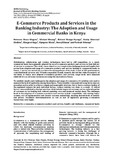| dc.contributor.author | Magutu, Peterson Obara | |
| dc.contributor.author | Mwangi, Michael | |
| dc.contributor.author | Nyaoga, Richard Bitange | |
| dc.contributor.author | Ondimu, Gladys Monchari | |
| dc.contributor.author | Kagu, Margaret | |
| dc.contributor.author | Mutai, Kipngeno | |
| dc.contributor.author | Kilonzo, Henry | |
| dc.contributor.author | Nthenya, Peninah | |
| dc.date.accessioned | 2013-06-20T15:18:48Z | |
| dc.date.available | 2013-06-20T15:18:48Z | |
| dc.date.issued | 2011 | |
| dc.identifier.citation | Journal of Electronic Banking Systems,Vol. 2011 (2011), Article ID 678961, 19 pages DOI: 10.5171/2011. 678961 | en |
| dc.identifier.uri | http://www.ibimapublishing.com/journals/JEBS/2011/678961/678961.pdf | |
| dc.identifier.uri | http://erepository.uonbi.ac.ke:8080/xmlui/handle/123456789/37016 | |
| dc.description.abstract | Globalization, collaboration and wireless technologies have led to stiff competition. As a result,
commercial banks have generally adopted the use of e-commerce products and services in their delivery
of services to customers. This study’s main objective was to explore the challenges faced and benefits that
accrue from adoption and usage of e-commerce products and services banking by commercial banks in
Kenya. A survey was carried out to achieve the envisaged aims of the study. A total of 100 questionnaires
were distributed however only 70 banks responded. Overall, research showed that while the majority of
the banks in Kenya have adopted e-commerce products and services, usage levels have remained
relatively low, as not many customers are using this innovation in Kenya.
To establish benefits and challenges in the adoption and usage of e-commerce, 32 variables were used to
measure the level of application among these banks. These variables were analyzed using factor analysis
procedure and in order to achieve a simple and meaningful structure, that is, have a nonzero loading of
the explained variance for each individual factors, varimax rotation was done. As a result, 10 critical
factors were established as the best practices which include: improved customer service, reduced number
of customers in the banking hall, reduced operating costs and increased market share. The challenges
faced in the adoption of e-commerce products and services include compatibility with existing legacy
systems, cost of implementation and security concerns ranked high, ensuring desired levels of security
and privacy. Unreliable telecommunication as well as lack of legislation governing e-commerce
transactions rated highly. | en |
| dc.language.iso | en | en |
| dc.publisher | University of Nairobi | en |
| dc.subject | e-commerce, e-commerce products and services, benefits and challenges, commercial banks | en |
| dc.title | E-Commerce Products and Services in the Banking Industry: The Adoption and Usage in Commercial Banks in Kenya | en |
| dc.type | Article | en |
| local.publisher | Department of Management Science, School of Business, University of Nairobi | en |
| local.publisher | Department of Management Science, Narok University College | en |


